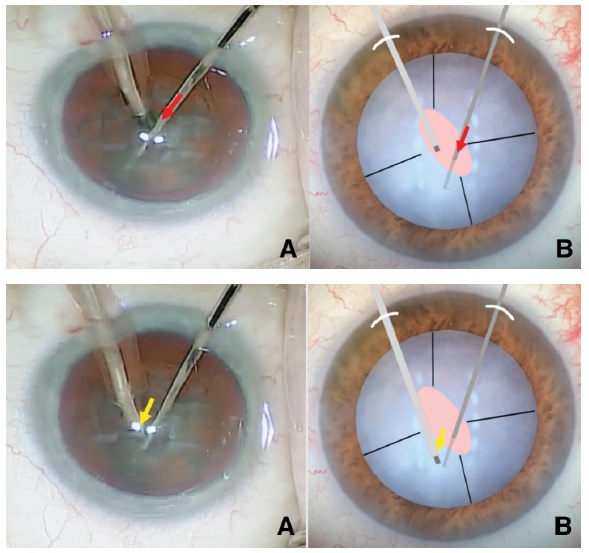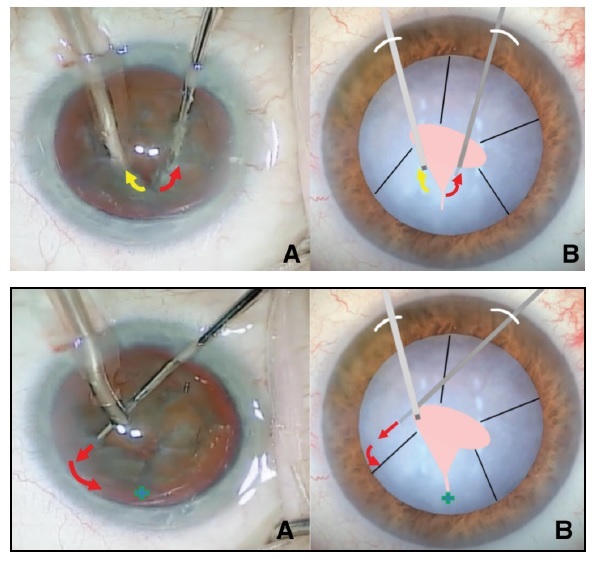The Impale Technique: An Approach for Softer Nuclei
Abstract
We describe a novel cataract surgery technique that can be used for soft nuclei, which present difficulties for removal even for experienced surgeons. Such nuclei typically don't crack as easily, tend to break into fragments, and don't allow for full thickness segmentation after grooving. After the nucleus is grooved with the phaco tip, subsequent steps are as follow: (1) the nucleus is impaled with a second instrument; (2) the phaco tip is placed near the second instrument and impaled into the nucleus; (3) the two hand pieces are separated while rotating in a clockwise fashion as rotation by the two instruments, while separating divides the nucleus into smaller fragments and aligns the next section of nucleus to be impaled. This process is repeated for the remaining nuclear fragments and allows for effective and efficient removal when these nuclei are encountered.
Introduction
Cataracts are the leading cause of vision loss in the world. About 18 million people are bilaterally blind due to cataracts, according to The World Health Organization (WHO), and are responsible for 48% of cases of blindness worldwide [1]. Cataract surgery has become the most performed outpatient surgery in the United States, with approximately 3 million surgeries to remove cataracts performed annually. Although phacoemulsification has been the preferred method in cataract surgery for several decades, instrument techniques and machine settings vary from surgeon to surgeon and commonly case to case.
Techniques that have been described thus far have been useful for medium to hard nuclei. One of the earliest includes the divide-and-conquer nucleofractis technique first described by Gimble [2], which is used by many cataract surgeons and newly trained residents. Another set of techniques include the Phacochop first described by Nagahara [3] and then modified to the stop and chop technique by Koch for nucleus removal [4]. Finally, the last technique discussed in this article is the pre-chop, which requires a special instrument and again requires a dense nucleus. The choice of technique is dependent on surgeon preference, surgeon comfort, and attributes of the cataract. The Impale technique was described and devised to overcome the difficulties of soft nuclei that do not crack (or divide) well. Soft nuclei can present difficulties for even experienced surgeons when using standard techniques as described above. Koch and Katzen describe that a soft nucleus cannot withstand the high vacuum settings to allow adequate hold of nuclear piece for chopping [4]. The Impale technique provides an option for surgeons to handle softer nuclei effectively and efficiently.
Surgical Technique
After discussing alternative treatments, benefits and risks, consent for the procedure is obtained. The surgery starts with the patient being prepped and draped in the usual sterile fashion and a lid speculum is then placed to hold open the eye. Under topical anesthesia, the surgery starts with a clear corneal incision with the paracentesis blade temporally. The anterior chamber is then irrigated with preservative free lidocaine followed by being filled with Viscoat (sodium hyaluronate 3.0%-chondroitin sulfate 4.0%). The next step is making the main incision for the surgery (usually 2.4 millimetre incision) using a keratome blade. A complete curvilinear capsulorhexis through the anterior capsule is then started with the bent-tip needle and completed with forceps, with a goal diameter of about 5.5 millimetres.
Good hydrodissection and hydrodelineation using a Chang hydrodissection cannula (Katena Products, Inc.) is attempted with the goal of free rotation of the nucleus and separation of the inner nucleus from the outer epinuclear shell. Phacoemulsification is then initiated with surgeon preference phaco tip and machine using the Infiniti Vision System (Alcon, Inc). Pre-phaco is performed, if indicated, to improve visualization by removing free cortical material. Nuclear groove is initiated in the soft nucleus usually without significant difficulty. A second instrument of the surgeon's choice is then inserted and the division of the nucleus to crack into two halves is attempted. It is at this step that the difficulty of a soft nucleus can first present itself.
Often, the crack will proceed as expected and the surgeon will try to rotate the half piece of the lens and note difficulty as the lens is too soft that the second instrument will impale one of the halves of nuclei. The steps of the impale technique will take place at this time of phacoemulsification and can be summarized as follows: (1) the nucleus is impaled with the second instrument; (2) the phaco tip is placed near the second instrument and impaled into the nucleus; (3) the two hand pieces are separated while rotating in a clockwise fashion as rotation by the 2 instruments while separating divides the nucleus into smaller fragments and aligns the next section of nucleus to be impaled; (4) repeat steps (1-3) for the entire 360 degrees of the nucleus. (Figure 1 and Figure 2) demonstrate nuclear grooving and insertion of the second instrument, in our case a chopper, respectively. (Figure 1, Figure 2, Figure 3 and Figure 4) demonstrate the four steps of the impale technique used in this case.
The nucleus is then divided into multiple segments and can easily be removed in sections from the capsular bag in the surgeon's preferred nuclear settings. Once the bulk of the nuclear fragments are removed, the remaining cortical material is removed via gentle irrigation and aspiration (I&A), with the posterior capsule usually polished with the I&A tip. The capsule is then filled with Provisc, and a posterior chamber intraocular lens (PC IOL) is inserted in the bag. The remaining Provisc is aspirated, then the chamber is reformed, and the wounds are hydrated with BSS on an irrigation cannula. To finish, the wounds are checked with a Weck cell and found to be sealed.
Discussion
The lens gradually increases in density and usually becomes less soft with age due to changes in lens protein structure due to processes such as oxidation. These properties normally allow separation via cracking to occur in a well-defined manner due to large protein aggregate formation [5]. If a lens with a softer nucleus is encountered, such aggregates are smaller and relatively lacking, and the nucleus easily fragments using standard techniques. The most commonly used technique when attempting to break down the lens is the divide-and- conquer technique. This technique is great for medium to hard lenses, and the goal of this technique is to offer safe and efficient phacoemulsification when cracking and dividing the lens.
The difference between the divide-and-conquer technique and the impale technique is that the second instrument, then phaco tip impale adjacent portions of a nucleus fragment, and mechanical separation of the fragment into two components is achieved by the two instruments rotationally in opposite directions. The pre-chop technique uses a special instrument to insert into a grooved lens and mechanically separate the nucleus into fragments, which essentially uses the instrument as a “parrot-beak”. The difference between the pre-chop and impale techniques is that a second instrument is used in the impale technique and that the impale technique doesn't require a special instrument. Divide-and-conquer and pre-chop is better for medium to hard lens', while the impale technique is optimal for a soft lens that might not crack well.
The advantages that the impale technique offers, when compared to the standard divide-and-conquer technique and pre-chop, is more effective and efficient for softer lenses in our experience. The risks that the impale technique bring to the patient and the surgeon can include increased procedure time when initially learning this technique, which can increase the risk of postoperative complications. However, these risks disappear, and nucleus removal becomes more efficient as this technique is mastered. To summarize, the impale technique offers a great option for cataract surgeons to overcome a soft lens that does not crack or separate well. Although this technique comes with much practice, this technique can be very beneficial to all cataract surgeons ranging from residents to expert and experienced surgeons alike.
References
- Sharon Jick L (2019) American academy of ophthalmology. BCSC Course: Lens and cataract.
- Gimbel HV (1991) Divide and conquer nucleofractis phacoemulsification: Development and variations. J Cataract Refract Surg 17: 281-291.
- Nagahara K (1993) Video of phaco chop. Presented at American society of cataract and refractive surgery, Seattle.
- Koch PS, Katzen LE (1994) Stop and chop phacoemulsification. J Cataract Refract Surg 20: 566-570.
- Moreau KL, King JA (2012) Protein misfolding and aggregation in cataract disease and prospects for prevention. Trends Mol Med 18: 273-282.
Corresponding Author
Caleb Liles, DO, Charles F Schrimpf Eye Center, 330 Forest Ave, Dayton, OH 45405, USA
Copyright
© 2022 Bloom J, et al. This is an open-access article distributed under the terms of the Creative Commons Attribution License, which permits unrestricted use, distribution, and reproduction in any medium, provided the original author and source are credited.






